AN ENDURING LEGACY:
100 Years of York’s Historic Strand Theatre and the Community That Made It Possible
The Strand Theatre’s story is the story of York City. It’s one of vision, resilience, and above all, a testament to the magic that happens when communities come together with a shared goal. Even though the Strand Theatre still leaves audiences speechless with its nostalgic beauty, it’s much more than a restored historic landmark. The Strand Theatre is a place of wonder — where dreams are born and realized, where friends and families come together to shape lifelong memories, and where a sense of community grows stronger each day.
On August 27, 2025, the 100th anniversary of the opening of the Strand Theatre, we take a look back and pay tribute to its rich history and all those who made it possible for it to still be standing, and thriving, to this day…
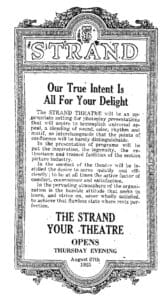
The Birth of a Downtown Landmark
In March 1924, York’s own Nathan Appell and his son Louis Appell, Sr. announced an ambitious vision. Their company, Appell Amusements Interests, planned to build a one-story, 1,350-seat theatre in the heart of downtown York, right on North George Street. The theater would be designed for motion pictures but adaptable for live stage performances, and there would be room for a balcony addition in the future. In June 1925, the Strand Theatre officially received approval for York City’s first-ever electrical marquee, and on August 27, 1925, the Strand Theatre doors opened for the first time.
In its earliest years, the Strand Theatre was a home for vaudeville acts and the golden age of film. In 1928, a major stage expansion made the theatre even more versatile, accommodating the larger productions of the Keith vaudeville circuit. “It was meant to give you a sense of a life you didn’t have. You could go and sit in this extravagance for 10 or 20 cents and see a movie and be treated like a king or queen. To me, it’s just magical to be in a space like that,” said Terry Nace from the Susquehanna Valley Theatre Organ Society.
The Strand Theatre was sold to Warner Bros. in 1930 as part of a nationwide acquisition of over 70 community theatres. Renovations in 1941 refreshed the interiors, added a twin marquee, and modernized stage systems to keep the theatre competitive in a rapidly changing entertainment market.
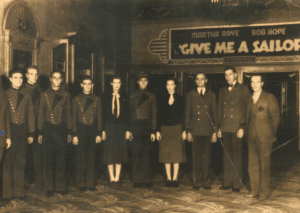
In 1948, the U.S. Supreme Court made a historic ruling that Hollywood studios violated antitrust rules, and Warner Bros. was forced to divest its theatre chains. And in March 1953, the Strand Theatre was once again sold, this time to RKO Stanley Warner. According to Kelley Gibson, President of the York County Cultural Alliance, “They got the space and then they just treated it poorly. And most of the theaters that happened to, closed. And many of its kind are gone now.”
Facing Challenges, Finding Strength
Like many downtowns across the country, York City faced challenges of race riots and economic challenges in the 60s and 70s. “We had big-name individuals, whether that was someone like Cab Calloway, that would come to York, Pennsylvania but they couldn’t stay at our hotels. They couldn’t be fed in our restaurants. So for a long time, there were programs coming to the theater that were diverse, but the environment itself was not inclusive. And all of that had an adverse effect on the arts,” stated Sam Dorm, Local Historian.
As the suburbs grew and entertainment options such as cinema megaplexes were born, downtown businesses suffered, including its historic theaters.
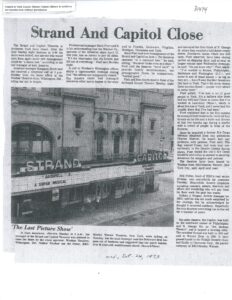
After more than 50 years in operation, the Strand Theatre closed its doors in 1976, joining a growing list of historic venues that seemed destined for demolition. But York wouldn’t let that happen. Shortly after the closure, the York Junior League, led by Anne Hoover, announced its plans to explore the possibility of renovating and reopening the Strand-Capitol complex. In 1978, the “Save Our Theaters” campaign united the community in an unprecedented show of support, raising over $1 million to restore both the Strand Theatre and its neighbor, the Capitol Theatre. But it wasn’t easy. “The main hurdles were, of course, raising that much money. I think only the York Hospital had raised more money in the community up to that time. The alternative was tearing it down and making it a parking lot, which was not something that was acceptable to us…. I think we all recognized that quality of life in any community is having the arts,” said Ben Hoover, champion of the fundraising project.
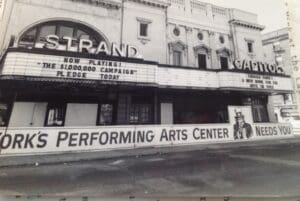
It was the passion of community leaders like Louis Appell, Jr., Ben and Anne Hoover, and Mayor John Krout that made the project possible. “They believed that a strong center core for York County was York City, and if York City survived, the rest of the county would thrive as well,” said Michael Hady, President and CEO of the Powder Mill Foundation.
A Triumphant Return
In April 1980, the newly restored Strand Theatre reopened with a gala featuring Ella Fitzgerald and the York Symphony Orchestra — a night that marked not only the rebirth of two beloved theatres, but also a defining moment in York’s City’s resurgence. And a new nonprofit organization, named the Strand-Capitol Performing Arts Center, was formed to steward these beloved venues and drive the strategic vision forward.
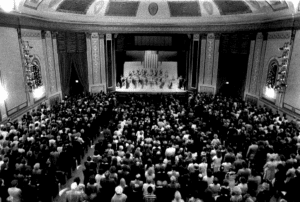
Decades of Growth and Generosity
The decades that followed brought growth and new opportunities. The late 1980s saw another wave of investment through the “Ovation” Campaign, which funded the renovation of the Lehmeyer Building and upgraded lighting, rigging, and marquees. It also retired the building’s mortgage and built an endowment fund. In 2000-2001, the “Setting the Stage” campaign invested over $7 million to complete the largest renovation project to date: expanding the facilities to their current footprint, enlarging the stage and adding the balcony, education wing, restrooms, box office, boardroom, offices, and new equipment and systems. Louis Appell Jr., grandson of Nathan Appell and son of Louis Appell, Sr., spearheaded this daunting community endeavor. The renovations and expansions added modern amenities, preserved the theatre’s historic charm, and enabled the Strand Theatre to host nationally touring Broadway productions today.


A Stage for All
From that moment on, the Strand Theatre thrived as a stage for both world-class performances and homegrown talent. The Strand Theatre welcomed an impressive roster of performances, such as Bernadette Peters, Chris Cornell, and John Legend. It became the home of beloved community programs like Stage the Page, which has given more than 150,000 local students their first taste of live theatre. And the Strand Theatre hosts numerous community events each year, serving as a launchpad for local students and budding artists. “For a brief moment, you look out in the audience [of the Strand Theatre] and you see the support, you see the amount of people who have come to watch the city kids. It showed me that I was capable of probably more than what I thought I was,” said former performing arts student, Augustine Mariche.

A New Name, a New Century
In May 2017, following the passing of Louis Appell Jr., the Strand-Capitol Performing Arts Center organization was renamed the Appell Center for the Performing Arts, honoring three generations of the Appell family who have been instrumental in the funding and preservation of the theatres. The historic moment was celebrated with a sold-out performance by the legendary Tony Bennett, with white roses raised by the entire audience to usher in this new era for York.

Just three years later, the COVID-19 pandemic forced another temporary theatre closure followed by significant limitations to programming. But yet again, the York community’s spirit shone through, helping the Appell Center return to more than 200 events annually in the Strand and Capitol Theatres in the following seasons. “We put a big push into our education and community engagement and finding new and unique ways to reach out to the young people of the community,” proclaimed Todd Fogdall, President & CEO of the Appell Center for the Performing Arts.

The Heart of York City Now and Into the Next Century
Now, as we celebrate the Strand Theatre’s centennial, we are reminded that our past is only the beginning. The best way to honor the last hundred years is to continue to cherish the space and ensure it remains open, inviting, and alive for the next hundred years — a place where the entire community feels they belong and where new stories will be told for the next generation. As Board President Elaine Bonneau said, “What we do today shapes the experience we want people, all people, anyone, to have in this space now and the next 100 years.”





























